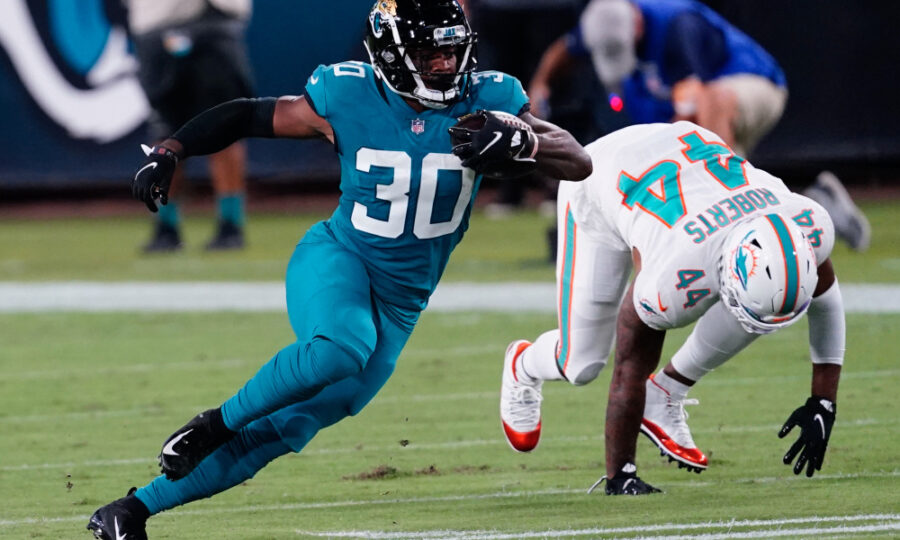NFL Game Scripts Week 4: Cincinnati Bengals @ Jacksonville Jaguars
Although their records may not show it, both the Cincinnati Bengals and Jacksonville Jaguars have been better than many expected before the season began. They have found ways to stay in games, and seem to have figured out their offenses. While their defenses have playmakers and can get some stops, there are holes that can be exploited that should make this a reasonably high-scoring affair.
Cincinnati Offense vs Jacksonville Defense

The Run Game
Within their pass-first mindset, the Bengals have the fifth-fewest rushing attempts, although they are third-last in total rushing yards and have the second-fewest yards per carry. QB Joe Burrow has nearly a quarter of those yards, and mostly from scrambles, especially with his OL allowing the most pressures of any team. Without proper protection up front, the Bengals need to consider how they can generate a rushing attack.
RB Joe Mixon hasn’t been effective running inside or outside the Tackles with the zone rushing scheme. While he has found gaps occasionally, he is often tackled for minimal gain. The Bengals will be aiming to see if Mixon can find gaps through the middle with his natural abilities, but will need to also scheme him extra protection. With Burrow’s agility, they should incorporate some read-option plays to get either him or Mixon in space, using TE Drew Sample to help block on the edge. Early in the game they should also use RB screens to supplement run plays, allowing the Jaguars’ rushers to get into the pocket, leaving fewer defenders downfield, with Mixon able to run behind Sample and WR AJ Green.
During the first half, the Bengals also need to use inside runs, which they can do with simple handoffs, knowing some will be ineffective, but allowing them to then use counters and misdirects more successfully. Additionally, the Bengals could explore putting Mixon and RB Giovani Bernard on the field together, so that they can further disguise their run plays. With Bernard usually used as a receiver, the Bengals can fake handoff to Mixon, using Bernard on runs through the middle, or Mixon as the receiver instead. These uses of their RBs could work a few times, as the defenders could be aligned to tracking Mixon through the middle and Bernard to the outside. Regardless, the Bengals will try to run inside and outside throughout the game, but need to be more complex in their play design than they have been so far this season. Using WRs Auden Tate or Tee Higgins on end arounds, jet sweeps and reverses could further help run the ball, but will only work a few times.
The Jaguars should be able to win their matchups with the interior OL, giving the edge rushers one-on-one matchups with the OTs. With few holes through the middle, the Jaguars can force Mixon to the outside, where they can deploy LBs Myles Jack and Joe Schobert by lining them up in the B gaps to stay inside if needed, or get outside quickly too. With defenders able to win their matchups, the Jaguars can overwhelm the Bengals’ front, forcing them to either abandon the run or dedicate extra protection, resulting in fewer receiving possessions, and thus losing their advantage and ability to disguise their plays.
The Passing Game
Cincinnati regularly use 3WR sets, with clearly defined roles for each of their WRs. Despite his success throughout his career, AJ Green has become the WR2 of the offense, mostly running short out, slant and curl routes, giving a big target to Burrow towards the outside. Instead, Tyler Boyd is the WR1, and he predominantly works with slants and downfield routes over the middle of the field, inside the numbers. The Bengals than use a combination of WRs Auden Tate, Tee Higgins and Mike Thomas as sideline receivers, usually sending them deep, but also at times with curls to stay underneath the defense for clear throwing lanes. Outside of the WRs, TE Sample occasionally runs slants and curls to the outside, but is rarely used downfield, while the RBs at times serve as check down release targets. Yet Sample, Bernard and Mixon are instead needed for pass protection, usually leaving the Bengals with just 3 or 4 receiving options.
Early in the game, the Bengals will stick with their 3WR sets and send Higgins or Tate downfield, with Boyd out of the slot crossing the middle of the field. If Green is on the field, he will be sent to the outside to match up with rookie CB CJ Henderson, with the former using his size to negate the latter’s impact on the game. Against the Jaguars’ zone defense, Boyd should have room to work over the middle, getting between the LBs and Safeties. During the first half, the Bengals will continue to attack downfield and see how effectively Burrow can find space, which will require quick throws and good timing as Boyd and Higgins get into space. Into the second half, the Bengals could explore more 4WR sets to get Tate or Thomas deep, allowing Higgins to then work over the top or underneath Boyd on slants and crossing routes, so that the Safety or LB is forced to commit short or deep, leaving space for Burrow to find the open receiver.
The Jaguars will be able to pressure Burrow with their front four, and shouldn’t blitz much, although will at times bring Henderson and Jack off the edge. With their base formation, the Jaguars have extra defenders against the pass, and can play Cover 2 most of the game, keeping a Safety over the top against the deep receiver. Bracketing Boyd over the middle with a CB and LB or Safety will force Burrow to throw to the outside more, testing Henderson, and causing riskier throws.
What should we expect to see on Sunday?
The Bengals will again not use a balanced attack, passing often. Their first half game plan should use some RB screens and 3WR sets to alleviate pressure on Burrow, testing what space Boyd and Higgins can have deep and over the middle. Into the second half, the Bengals will expand into 4WR sets more often, and use fewer run plays, mostly using Mixon on the outside when they do choose to run. The Jaguars will stick with their nickel Cover 2 formation, winning at the line of scrimmage with just 3 or 4 pass rushers, and will aim to take away the deep pass with a Safety over the top, and bracketing Boyd over the middle where possible.
Jacksonville Offense vs Cincinnati Defense
The Run Game

If the Bengals’ run game has been neglected, the Jaguars haven’t been much better, having the fourth-fewest attempts in the league, despite having the seventh-best YPC in the league. This has mostly been due to game scripts, with Jacksonville having to play from behind or in shootouts, but against the Bengals, the Jaguars should be able to run more often. The Bengals have allowed the second-most rush yards in the league, and are tougher against the pass, favouring the Jaguars’ ground game.
Jacksonville will use RB James Robinson up the middle in a power-run scheme behind FB Bruce Miller. In particular, they will attack through the left side of their OL, as OG Andrew Norwell can set up good rushing lanes. Robinson will follow the holes created for him, and should be able to have success up the middle. Occasionally throughout the game, the Jaguars will run Robinson to the outside, with TE James O’Shaughnessy acting as a blocker to help the RB reach the space out wide.
Every so often, WR Laviska Shenault will be used on end arounds and as a runner too, although he is mostly used outside of the Tackles. Shenault allows the Jaguars to disguise their formations and play design, as they can stay in 11 personnel, showing pass, but then using draw and delay plays with Robinson or Shenault. Moreover, the Jaguars can then fake handoffs to either Robinson or Shenault, using the other to attack the inside or outside, respectively. These plays will increase into the second quarter, with a few designed runs for Gardner Minshew also used sparingly. By the second half the Jaguars will have found holes to run through in the middle, and target these increasingly, while at times still attacking the outside to keep the Bengals’ defense honest.
Cincinnati’s struggles against the run have partly been their lack of presence in the middle of their defense. They predominantly use a nickel formation, bringing a 3rd DB into the box to defend the edge and restrict runs to the outside, which they can also use to guard TEs. With the Jaguars 3WR sets, the Bengals will stay in their nickel base, but need to find a way to limit runs through the middle. The Bengals don’t attack the A gaps much, and could choose to do so to force Robinson to the outside more, where Vonn Bell provides an extra defender.
The Passing Game
The Jaguars’ passing attack uses their WRs in different ways to exploit holes in the defense. TE Tyler Eifert has begun to serve as a weapon on intermediate routes to the outside, and as a target in the red zone, and will see more targets late into the second quarter and beyond. Robinson will be sent on a few swing and release routes to the outside, but unless they fall behind, these will be used minimally outside of a few 2nd down plays.
Instead, the Jaguars will pass often in the first half, using DJ Chark as a downfield, vertical receiver, with Collin Johnson as a second deep target at times, although he will run deeper crossing and go routes. Chris Conley and Keelan Cole are typically the WR2 and WR3, and they alternate between running intermediate and short routes, working inside and to the outside. Shenault and Dede Westbrook are typically used as slot receivers, and rotate in for receivers over the middle, able to add yards after the catch. These different combinations allow the Jaguars to use hi-lo levels and flood passing concepts, varying their use of Chark and Johnson over the top, Cole and Conley through the middle, and Westbrook and Shenault short and down the numbers. These formations will remain consistent throughout the game, although more 4WR formations will be used if they fall behind.
The Bengals will be able to cover the outside of the field reasonably well, with Safety Jessie Bates III providing coverage over the top as a single high safety. Chark will have little space to work, and Bates’ presence could see the Jaguars respond by bringing in Johnson as a second deep threat to force Bates to commit to one. With CB William Jackson playing the outside, it will limit Cole and Conley to an extent, but the Jaguars should be able to at the very least find the short/underneath receiver open. The Bengals will need to keep their LBs in the middle of the field over the top of the Tackles after the snap, so that as the routes develop, they can react to where the receiver is running. Consequently, the Jaguars should see space open up as the Bengals are forced to react, rather than forcing Jacksonville to play the way Cincinnati want them to.
What should we expect to see on Sunday?
Jacksonville will use their WR depth to attack all over the field during the first half, running Robinson inside to help create space on the outside. If the game remains close, Jacksonville will start attacking deep more, trying to find space in the middle of the field on intermediate routes, before targeting Eifert to the outside. If they build up a lead, the Jaguars will increase their run plays in the third quarter, forcing the Bengals to either commit an extra LB to defending the run and opening up passing plays again, or adding chunk yardage repeatedly. The Bengals will mostly react to the Jaguars instead of forcing them into a certain style, allowing Jacksonville to control the pace of the game.

